|
|
General: SAN MARCOS-TORRE DEL RELOJ-VENECIA (CLOCK TOWER-ST MARK-VENICE)
Scegli un’altra bacheca |
|
Rispondi |
Messaggio 1 di 43 di questo argomento |
|
St Mark's Clocktower
From Wikipedia, the free encyclopedia
Coordinates:  45°26′05″N 12°20′20″E / 45.43471°N 12.338912°E / 45.43471; 12.338912 45°26′05″N 12°20′20″E / 45.43471°N 12.338912°E / 45.43471; 12.338912
The Clock Tower in Venice is an early renaissance building on the north side of the Piazza San Marco at the entrance to the Merceria. It comprises a tower, which contains the clock, and lower buildings on each side. It adjoins the eastern end of the Procuratie Vecchie. Both the tower and the clock date from the last decade of the 15th century, though the mechanism of the clock has subsequently been much altered. It was placed where the clock would be visible from the waters of the lagoon and give notice to everyone of the wealth and glory of Venice. The lower two floors of the tower make a monumental archway into the main street of the city, the Merceria, which linked the political and religious centre (the Piazza) with the commercial and financial centre (the Rialto). Today it is one of the 11 venues managed by the Fondazione Musei Civici di Venezia.

St Mark's Clocktower (Torre dell'Orologio), c.1860/70, by Carlo Ponti
General Description[edit]
On a terrace at the top of the tower are two great bronze figures, hinged at the waist, which strike the hours on a bell. One is old and the other young, to show the passing of time and, although said to represent shepherds (they are wearing sheepskins) or giants (they are huge figures of great mass, necessary so that their form can be recognized at a distance) they are always known as "the Moors" because of the dark patina acquired by the bronze. The bell is also original and is signed by one Simeone who cast it at the Arsenal in 1497.[1]

The clock tower in 1945 soon after liberation
Below this level is the winged lion of Venice with the open book, before a blue background with gold stars. There was originally a statue of the Doge Agostino Barbarigo (Doge 1486-1501) kneeling before the lion, but in 1797, after the city had surrendered to Napoleon, this was removed by the French, who were purging the city of all symbols of the old regime.[2]
Below again, is a semi-circular gallery with statues of the Virgin and Child seated, in gilt beaten copper. On either side are two large blue panels showing the time: the hour on the left in Roman numerals and the minutes (at 5 minute intervals) on the right in Arabic numerals. Twice a year, at Epiphany (6 January) and on Ascension Day (the Thursday 40 days after Easter, counting both days) the three Magi, led by an angel with a trumpet, emerge from one of the doorways normally taken up by these numbers and pass in procession round the gallery, bowing to the Virgin and child, before disappearing through the other door.

The gallery with Virgin & child
Below this is the great clock face in blue and gold inside a fixed circle of marble engraved with the 24 hours of the day in Roman numerals. A golden pointer with an image of the sun moves round this circle and indicates the hour of the day. Within the marble circle beneath the sun pointer are the signs of the zodiac in gold (these are original and date from the 1490s), which revolve slightly more slowly than the pointer to show the position of the sun in the zodiac. In the middle of the clockface is the earth (in the centre) and the moon, which revolves to show its phases, surrounded by stars which are fixed in position. The background is of blue enamel. The smaller blue circles in the four corners are not now used.
Below the clock is the archway, two storeys high, through which the street known as the Merceria leaves the Piazza on its way to the Rialto (This section of the Merceria is known as the Merceria dell'Orologio (of the clock)).
The buildings on each side have been let off separately as shops and apartments since the early 18th century.
On the other side of the tower there is another great clock face above the arch, visible to people walking down the street towards the Piazza. This is a simpler affair, again surrounded by a marble circle marked with the 24 hours, but in two series of 12 hours each. The sun pointer, marking the hours, is the only moving part on this side.
The construction of the tower and the clock[edit]
By 1490 an old clock at the north-west corner of St Mark's church, the clock of St Alipio, was in a very bad state and in 1493 the Senate commissioned the construction of a new clock.[3] The making of the clock was entrusted to a father and son, Gian Paolo and Gian Carlo Ranieri, of Reggio Emilia[4] In 1495 the Senate decided that a tower to hold the clock should be erected at the point where the street known as the Merceria leaves the Piazza. Buildings were demolished to make room for it and building started in 1496.

The clocktower in 1500 when it had just been completed (from de Barbari's woodcut of Venice)
The design of the tower is generally attributed on grounds of style (though without documentary evidence) to Mauro Codussi.[5] The Merceria passes through the archway at the foot of the tower. It is one of the principal streets of the city and leads to the Rialto. Deborah Howard explains how the idea was probably derived by Codussi from Alberti's work 'De re aedificatoria' ("About Building"), published earlier in the 15th century, where he emphasises the importance of towers to a city and the appropriateness of a monumental archway as the entrance to its principal street.[6]
The name of the sculptor who modeled the figures of the Moors is not known for certain. They have been most often attributed to Paolo Savin, but an article published in 1984 reached the conclusion that the most likely candidate is Antonio Rizzo. They were cast in bronze in 1494 by Ambrosio delle Anchore.[7]
The tower was built during 1496 and 1497 and the mechanism of the clock was then built into it under the supervision of the Ranieri. No expense was spared in the decoration of the tower and the clock, using quantities of ultramarine and gold leaf.[8] Even the 'Moors' were originally gilded.[9] The inauguration of both tower and clock took place on 1 February 1499. Sanudo wrote in his diary for this day that the clock was uncovered and seen for the first time as the Doge was leaving the Piazza to go to hear vespers at Sta Maria Formosa, adding that it was made with great ingenuity and was most beautiful.[10] Codussi died in 1504 and the wings on either side of the tower were added by 1506 (perhaps to give greater stability to the whole).[11] Barbari's great woodcut of Venice dated 1500 shows the newly built clock tower, before the wings were built, rising high above the original 12th-century Procuratie on either side. These Procuratie were lower than the present buildings, with only one storey above the arches on the ground floor, so that the tower then rose high above all the buildings on that side of the Piazza.
The wings are sometimes attributed to Pietro Lombardi, who was later to rebuild the Procuratie on the same side of the Piazza, but the wings are of no great distinction and more probably designed by Gonella who was then the proto (buildings manager) of St Marks.[12] The wings were also originally two storeys lower than today, with the roof at the level of the existing terraces.[13] A drawing by Canaletto shows the tower before the increase in the height of the wings. This makes the tower itself appear higher so that it makes a more positive statement as the grand entrance to a great city.[14]
By 1500, when the final account for the tower was passed, the elder Raineri had died. It was arranged that his son should remain in Venice to look after the clock and he was granted flour concessions which would give him a good income. He lived in Venice until his death in 1531.[15]
Alterations to the building and clock[edit]
For more detailed and technical information about the clock, see the separate article on the clock.
By 1531, after the death of Carlo Raineri, the clock was already not working properly. The Council of Ten decided that a permanent keeper must be appointed to live in a wing of the tower and be responsible to keep the clock in working order. Later, in 1551, Jacopo Sansovino, then the architect responsible for St Marks, was instructed to report on the state of the tower and clock. Major repairs were required, but by 1581, when his son, Francesco, published his description of Venice, all appears to have been in order.[16]
Shortly before 1663 the clock face was cleaned and the blue and gold colours restored 'like new'. Already by this date the procession of the Magi did not take place daily but only at certain festivals and also every hour of the day on every day while the Ascension Day celebrations lasted.[17]
By 1750 both tower and clock were badly in need of repair and restoration. In 1751 Giorgio Massari was employed to restore the buildings. In 1755 work started to add two additional floors above the roof terraces of the wings on either side of the tower.[18] Andrea Camerata took over from Massari in 1757. The eight columns on the front of the ground floor were added in that year, presumably for extra strength.
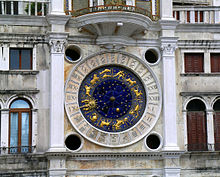
The clock face after restoration (2006)
Bartolomeo Ferracina was chosen to restore the clock mechanism. He made very extensive alterations, changing the movement from a foliot escapement to a pendulum system, which was much more accurate. The bands in the clock face which had previously shown the apparent movement of the planets round a central earth were removed. The marble circle round the clock face which had been marked, as now, with 24 hours, was covered by a circle showing two series of 12 hours and the Moors were also made to strike the bell in 12-hour cycles, with special rings involving 132 strokes of the bell, at midday and midnight. These changes were complete by 1757. Ferracina then turned his attention to the procession of the Magi, which had apparently not worked for many years, and the new mechanism was inaugurated on Ascension Day 1759. In order to prevent undue wear and tear, this continued to work only during the fortnight after Ascension Day.
By 1855 repairs were needed again. The top floor of the tower was reinforced and staircases were replaced by iron stairs. In 1858 Luigi de Lucia repaired and made further alterations in the clock mechanism, but preserving the essentials of the changes which had been made by Ferracina.
At this time a completely new feature was added, so that the time could be read more accurately than was previously possible. Panels were made to appear in the doorways on either side of the Virgin and child, above the clock face. Those on the left show the hour while those on the right show the minutes (changing every 5 minutes), each with white letters on a blue ground. The numbers blocked the route of the Magi and additional machinery was designed to lift them out of the way when the processions took place. They originally had gas lights behind them so that they could be read at night. The mechanism operating these numbers caused trouble and was not working properly until 1866. Other improvements and alterations were also made in 1865/66 by Antonio Trevisan and Vincenzo Emo.
The two 12-hour cycles round the main face of the clock remained until about 1900 when the original 24-hour circle was discovered beneath them and they were removed.
Further adjustments were made in 1953 and the latest, extensive series of repairs and alterations (some causing controversy amongst horologists) were carried out from 1998 to 2006 (five hundred years after the tower and clock were first completed).
Visits to the Clock Tower[edit]
Stairways (steep and narrow) inside the building give access to the terrace on the roof, passing the clock mechanism on the way. Tours (in Italian, English and French) must be booked in advance.
https://en.wikipedia.org/wiki/St_Mark%27s_Clocktower
|
|
|
|
Rispondi |
Messaggio 14 di 43 di questo argomento |
|
|
|
|
Rispondi |
Messaggio 15 di 43 di questo argomento |
|
Paris, France
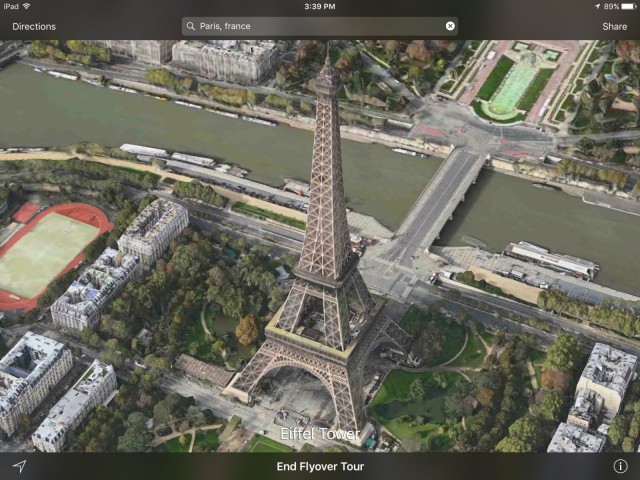 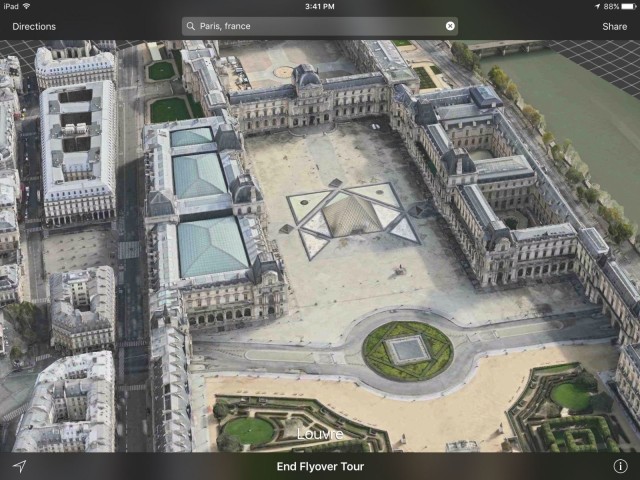
Well duh. Is anyone going to dispute that looking at a 3-D Eiffel Tower isn’t awesome? Plus it’s worth checking out other landmarks like the crystal clear Le Louvre.
Yosemite National Park, CA
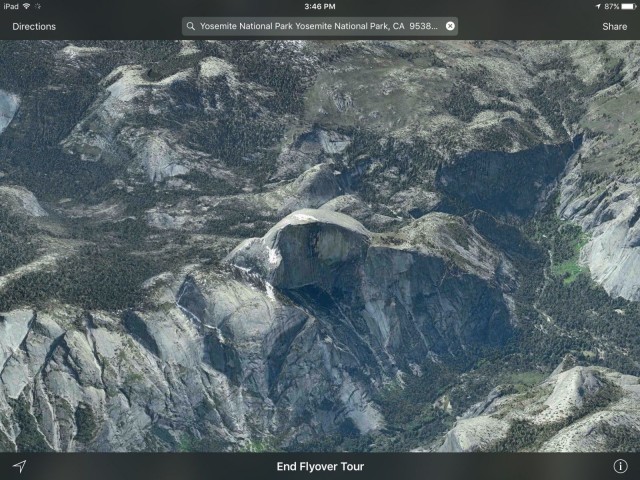 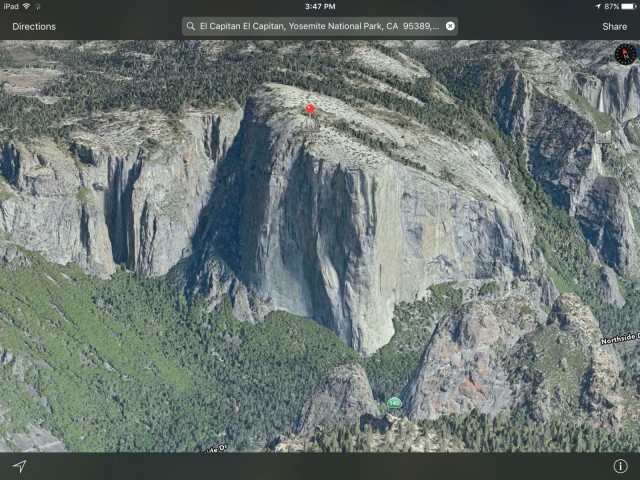
Let’s not forget that Apple named an operating system after this place – it must be pretty nice to look at. Even a specific mountain within the park – El Capitan – will soon debut to grace the list of Mac operating system names.
London, England
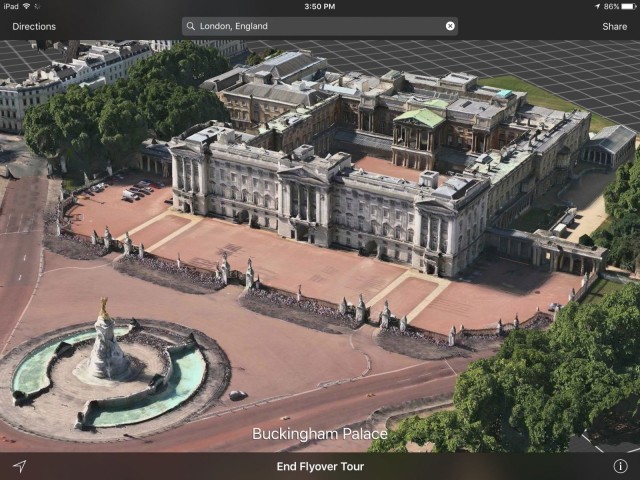 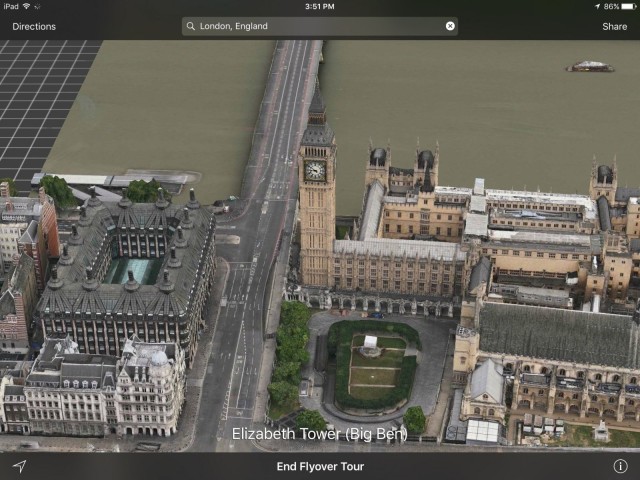
Here’s another no brainer. Like Rome, you can spend well over an hour looking through all that London has to offer. Check out the Big Ben or take a stop at Buckingham Palace. The city is colorful and creative with a fascinating mix of modernity and antiquity.
Mount Rushmore, SD
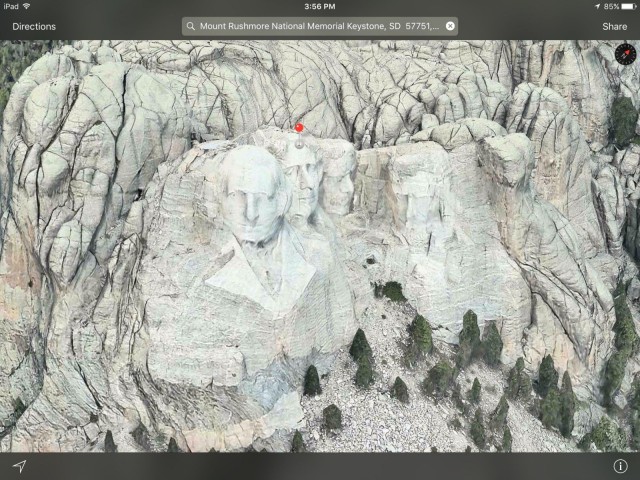 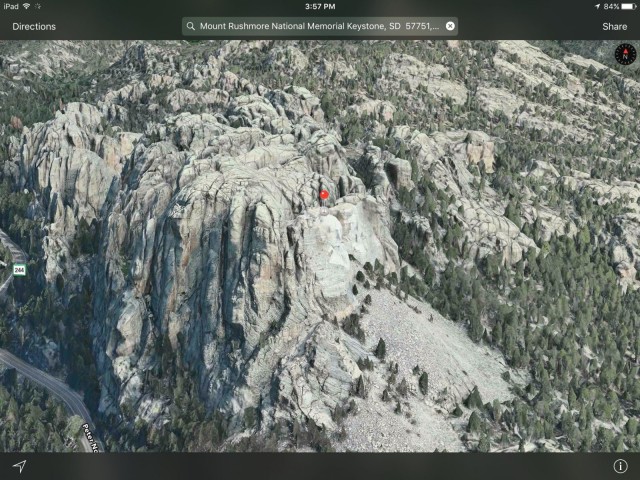
In between big cities, take a quick pick at Mount Rushmore in South Dakota. There’s not much to look at apart from the faces of four U.S. presidents, but that alone is worth your time. The sculpting game is so on point.
Venice, Italy
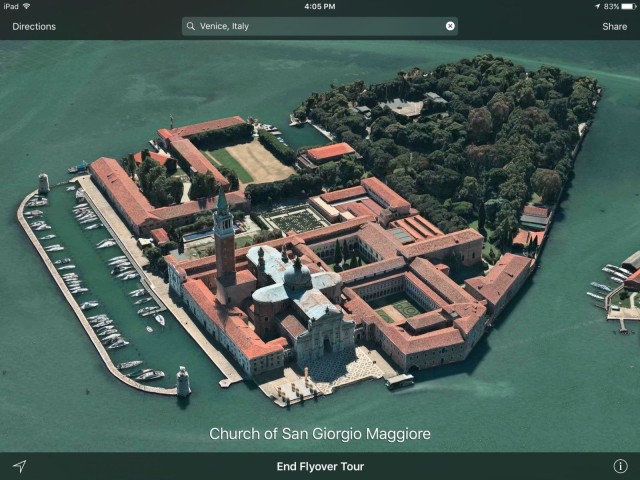 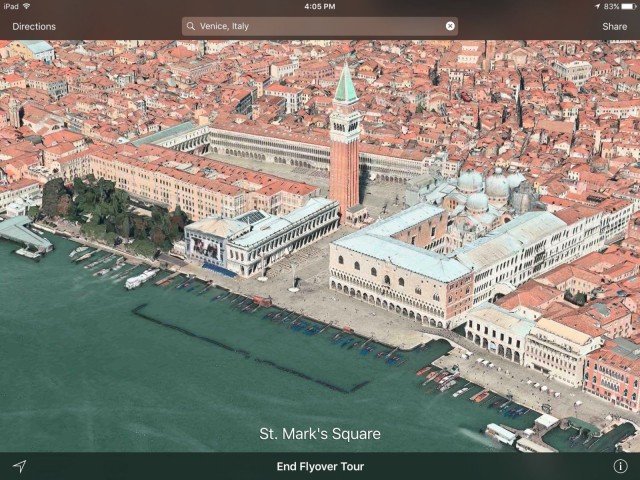
One of the newer entries to Apple’s Flyover list, it’s worth looking down at Venice. You immediately get a feel for how many people use the canals intertwined with the city as a means for transportation. Landmarks like St. Mark’s Square are nicely on display as well.
http://www.cultofmac.com/327199/apple-maps-best-of-flyover/ |
|
|
|
Rispondi |
Messaggio 16 di 43 di questo argomento |
|
From high atop a column the symbol of Venice, the winged lion of St. Mark, greets visitors to Piazza San Marco.
|
|
|
The Lion, Campanile and Doge's Palace
|
The square's original bell tower, or campanile, collapsed in 1902 but was rebuilt.
 |
| The Campanile |
Across from the campanile is the Palazzo Ducale, or the Palace of the Doges, built of pink and white limestone in the Venetian Gothic style .
 |
| Doge's Palace, Venice |
A wide promenade, the Riva degli Schiavoni, runs along the water's edge from the Doge's Palace to the Arsenal, the shipbuilding yards of Venice.
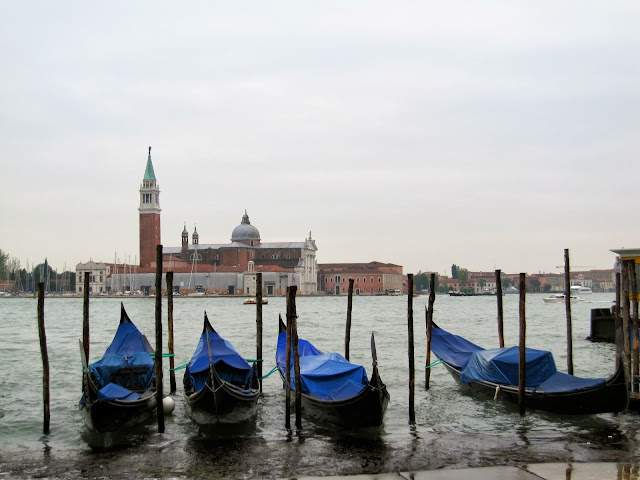 |
| Gondolas on the Riva degli Schiavoni |
A stroll along the promenade takes you past the Vitorrio Emmanuel II monument.
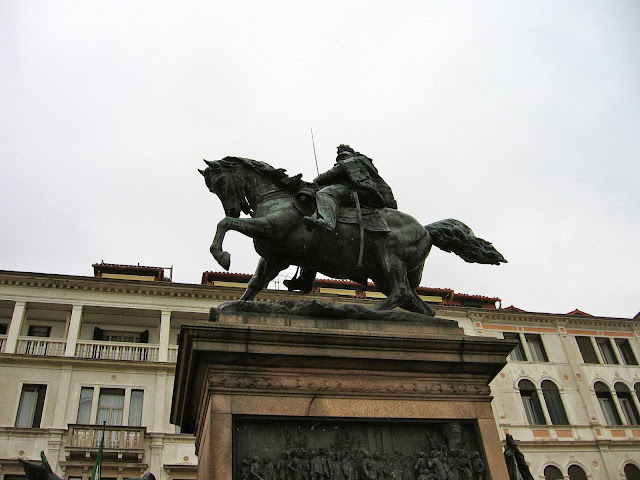 |
| Vittorio Emanuel II Monument |
The Tourist, a 2010 movie starring Johnny Depp and Angelina Jolie, was filmed at the nearby Hotel Danieli.
 |
| Floral Display at the Hotel Danieli |
If you encounter a crowd atop a small bridge, they have stopped to admire Il Ponte dei Sospiri, or the Bridge of Sighs.
 |
Bridge of Sighs
|
The bridge was named by Lord Byron for the sighs of prisoners as they took their last look at freedom, and the beauty of Venice, before being led to the Doge's prison. Giacomo Casanova was the prison's most famous captive - and he managed to escape.
 |
The Doge's Prison
|
Beyond Venice in the lagoon, the island of Murano is famous for its glass blowing factories. The factories were located outside of Venice to protect the population from the dangers of fire, and also to protect the glass makers' secrets.
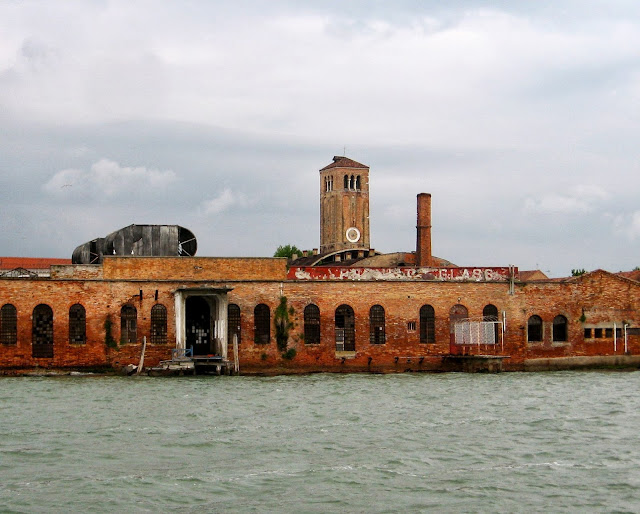 |
The Island of Murano
|
 |
The Lighthouse of Murano
|
 |
| The Art of Glass Blowing |
Back at Piazza San Marco, Robert Langdon approaches the basilica of St. Mark's.
 |
Piazzetta di San Marco
|
 |
| St. Mark's Basilica |
Another lion keeps watch from St. Mark's Clock Tower.
 |
St. Mark's Clock Tower
|
 |
| Astronomical Clock |
Beneath the Clock Tower is an archway which leads to the Mercerie, the main shopping street of Venice that runs between Piazza San Marco and the Rialto Bridge.
 |
| Clock Tower Archway |
On the central peak of the basilica, a statue of St. Mark stands over the bronze horses looted from Constantinople during the Crusades. Centuries later, Napoleon sent the horses to Paris to sit on top of the Arc de Triomphe. The original horses are now inside the basilica - the ones outside are copies.
 |
The Domes of St. Mark's
|
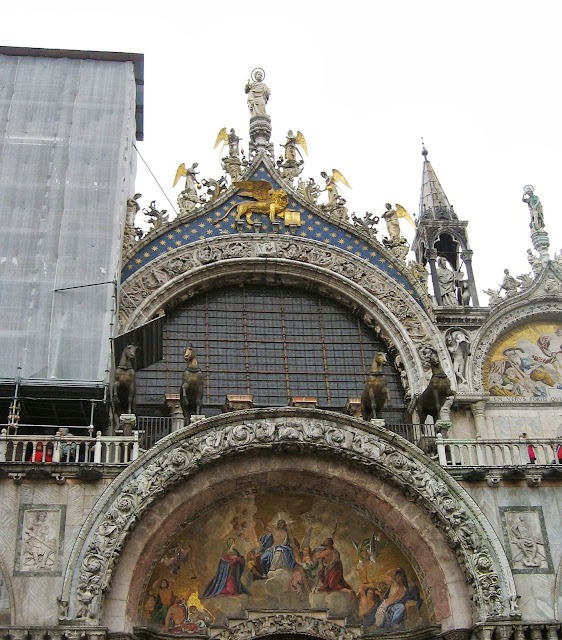 |
Statue of St. Mark
|
 |
The Horses of St. Mark's
|
 |
| The Winged Lion of St. Mark |
|
|
|
|
https://destinationfiction.blogspot.com.ar/2013/05/dan-browns-inferno-venice-in-photos.html
|
|
|
|
|
|
Rispondi |
Messaggio 17 di 43 di questo argomento |
|
168. Juan 16:21 La mujer cuando da a luz, tiene dolor, porque ha llegado su hora; pero después que ha dado a luz un niño, ya no se acuerda de la angustia, por el gozo de que haya nacido un hombre en el mundo.
24X7=168 |
|
|
|
Rispondi |
Messaggio 18 di 43 di questo argomento |
|
2. Daniel 2:27 Daniel respondió delante del rey, diciendo: El MISTERIO que el rey demanda, ni sabios, ni astrólogos, ni magos ni adivinos lo pueden revelar al rey.
22/7=3.14= PI-RAMIDE
| Reply |
Message 106 of 106 on the subject |
|
|
MONTE HERMON (TRIBU DE DAN)
DAN-IEL / PARALELO 33
MON / MOON / LUNA / TRANSFIGURACION
LINAJE DE A-DAN
58. Génesis 49:16 DAN juzgará a su pueblo, Como una de las tribus de Israel.
Será DAN
serpiente junto al camino, Víbora junto a la senda, Que muerde los talones del caballo, Y hace caer hacia atrás al jinete
.
|
|
|
|
|
|
|
Rispondi |
Messaggio 19 di 43 di questo argomento |
|
|
Rispondi |
Messaggio 20 di 43 di questo argomento |
|
EL MISMO RELOJ ES EL NEXO CON LA INDEPENDENCIA EN FILADELFIA DE LOS ESTADOS UNIDOS (13 ESTADOS/ SANTA CENA)
| Reply |
Message 113 of 114 on the subject |
|
|
|
|
| Reply |
Message 114 of 114 on the subject |
|
|
|
|
|
|
|
Rispondi |
Messaggio 21 di 43 di questo argomento |
|
|
| Reply |
Message 28 of 28 on the subject |
|
|
#3 Ley De Vibración
Nada está inmóvil: todo se mueve, todo vibra.
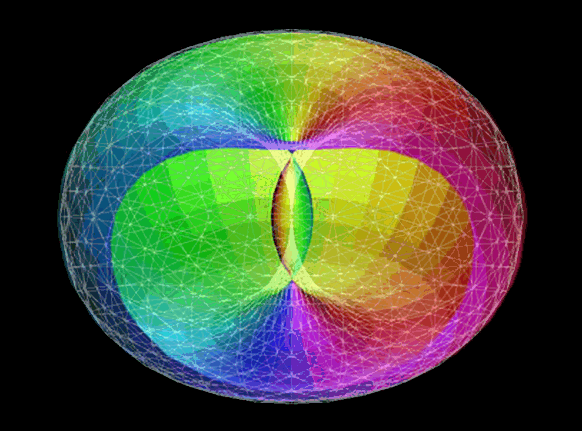 Este principio encierra la verdad de que todo el universo está en movimiento, de que nada permanece inmóvil, cosas ambas que confirma por su parte la ciencia moderna, y cada nuevo descubrimiento lo verifica y comprueba. Y, a pesar de todo, este principio hermético fue enunciado cientos de años por los Maestros Herméticos del antiguo Egipto.  Este principio explica las diferencias entre las diversas manifestaciones de la materia, de la fuerza y de la mente, las que no son sino el resultado de los varios estados vibratorios. Este principio explica las diferencias entre las diversas manifestaciones de la materia, de la fuerza y de la mente, las que no son sino el resultado de los varios estados vibratorios.
Entonces, si el universo es mental #1, por que lo podemos sentir físicamente? ...  La respuesta es: #3 La vibración, ya que por mínimo que sea el espacio de un átomo, su alta o baja vibración genera que el átomo ocupe todo el espacio vacío, y de esta manera está compuesta la materia física. La respuesta es: #3 La vibración, ya que por mínimo que sea el espacio de un átomo, su alta o baja vibración genera que el átomo ocupe todo el espacio vacío, y de esta manera está compuesta la materia física.
Ejemplo de vibración: Las aspas de un abanico, Apagado, solo ocupa un pequeño espacio y poca masa, Pero Encendido (Vibrando) a gran velocidad, la masa toma la mayoría del espacio, o de igual manera una rueda que gira rapidísimamente parece que está sin movimiento.
Pero por ley #2 de correspondencia en el otro extremo de la escala, hay formas de materia densísima, cuya vibración es tan débil que parece también estar en reposo.
Entre ambos polos hay millones de millones de grados de intensidad vibratoria. 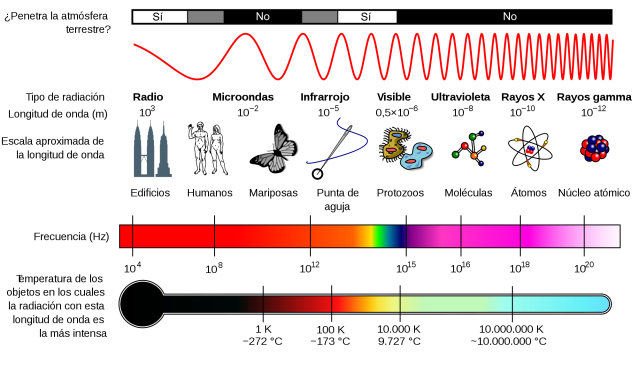 Los Maestros también emplean este principio para conquistar los fenómenos naturales. Los Maestros también emplean este principio para conquistar los fenómenos naturales.
"El que comprenda el principio vibratorio ha alcanzado el cetro del poder", ha dicho uno de los más antiguos escritores.
Ejemplo de una persona que media la naturaleza del universo en vibraciones y ondas, en lugar de masa, espacio y tiempo... 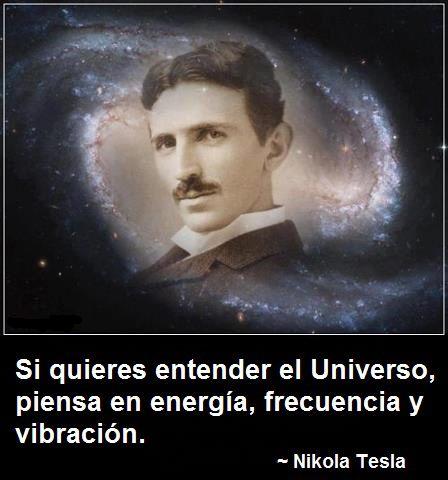 
#4 Ley De Polaridad (Dualidad)
"Todo es doble, todo tiene dos polos; todo, su par de opuestos: los semejantes y los antagónicos son lo mismo; los opuestos son idénticos en naturaleza, pero diferentes en grado; los extremos se tocan; todas las verdades son medias verdades, todas las paradojas pueden reconciliarse".
 Este principio explica que en cada cosa hay dos polos, dos aspectos, y que los "opuestos" no son, en realidad, sino los dos extremos de la misma cosa, consistiendo la diferencia, simplemente, en diversos grados entre ambos. El calor y el frío, aunque opuestos, son realmente la misma cosa, consistiendo la diferencia, simplemente, en diversos grados de aquella.
El mismo principio se manifiesta en la "luz" y la "oscuridad", las que, en resumen, no son sino la misma cosa, siendo ocasionada la diferencia por la diversidad de grado entre los dos polos del fenómeno.  El mismo principio opera de idéntica manera en el plano mental. Tomemos, por ejemplo, el amor y el odio, dos estados mentales completamente distintos aparentemente, y notaremos que hay muchos grados entre ambos; tantos, que las palabras que nosotros usamos para designarlos, "agradable" y "desagradable", se esfuman una en la otra, hasta tal punto que muchas veces somos incapaces de afirmar si una cosa nos causa placer o disgusto. El mismo principio opera de idéntica manera en el plano mental. Tomemos, por ejemplo, el amor y el odio, dos estados mentales completamente distintos aparentemente, y notaremos que hay muchos grados entre ambos; tantos, que las palabras que nosotros usamos para designarlos, "agradable" y "desagradable", se esfuman una en la otra, hasta tal punto que muchas veces somos incapaces de afirmar si una cosa nos causa placer o disgusto.  Todas no son más que gradaciones de una misma cosa, como lo ves claramente por poco que piensen sobre ello. Y aun más que esto, es posible cambiar o transmutar las vibraciones de odio por vibraciones de amor, en la propia mente y en la mente de los demás lo que es considerado como lo más importante por los hermetistas. Todas no son más que gradaciones de una misma cosa, como lo ves claramente por poco que piensen sobre ello. Y aun más que esto, es posible cambiar o transmutar las vibraciones de odio por vibraciones de amor, en la propia mente y en la mente de los demás lo que es considerado como lo más importante por los hermetistas.
La perfecta comprensión de este principio capacita para cambiar la propia polaridad, así como la de los demás, si uno se toma el tiempo y estudia lo necesario para dominar este arte. 
#5 Ley del ritmo (Frecuencia)
"Todo fluye y refluye; todo tiene sus períodos de avance y retroceso, todo asciende y desciende; todo se mueve como un péndulo; la medida de su movimiento hacia la derecha, es la misma que la de su movimiento hacia la izquierda; el ritmo es la compensación".
 Este principio encierra la verdad de que todo se manifiesta en un determinado movimiento de ida y vuelta, un flujo y reflujo, una oscilación de péndulo entre los dos polos que existen de acuerdo con la ley #4 de polaridad. Este principio encierra la verdad de que todo se manifiesta en un determinado movimiento de ida y vuelta, un flujo y reflujo, una oscilación de péndulo entre los dos polos que existen de acuerdo con la ley #4 de polaridad.
Hay siempre una acción y una reacción, un avance y un retroceso, una ascensión y un descenso. Y esta ley rige para todo; soles, mundos, animales, mente, energía, materia. Esta ley lo mismo se manifiesta en la creación como en la destrucción de los mundos, en el progreso como en la decadencia de las naciones, en la vida, en las cosas todas, y, finalmente, en los estados mentales del hombre, y es con frecuencia a esto último que creen los hermetistas que este principio es el más importante.  El Maestro se polariza a sí mismo en el punto donde desea quedarse, y entonces neutraliza la oscilación rítmica pendular que tendería a arrastrarlo hacia el otro polo. Todos los que han adquirido cierto grado de dominio sobre sí mismos ejecutan esto hasta cierto punto, consciente o inconscientemente, pero el Maestro lo efectúa conscientemente, y por el solo poder de su voluntad alcanza un grado tal de estabilidad y firmeza mental casi imposible de concebir por esa inmensa muchedumbre que va y viene en un continuado movimiento ondulatorio, impulsada por ese principio de ritmo. Este, así como el de la polaridad, ha sido cuidadosamente estudiado por los hermetistas, y los métodos de contrabalancearlos, neutralizarlos y emplearlos, forman una de las partes más importantes de la alquimia mental hermética. El Maestro se polariza a sí mismo en el punto donde desea quedarse, y entonces neutraliza la oscilación rítmica pendular que tendería a arrastrarlo hacia el otro polo. Todos los que han adquirido cierto grado de dominio sobre sí mismos ejecutan esto hasta cierto punto, consciente o inconscientemente, pero el Maestro lo efectúa conscientemente, y por el solo poder de su voluntad alcanza un grado tal de estabilidad y firmeza mental casi imposible de concebir por esa inmensa muchedumbre que va y viene en un continuado movimiento ondulatorio, impulsada por ese principio de ritmo. Este, así como el de la polaridad, ha sido cuidadosamente estudiado por los hermetistas, y los métodos de contrabalancearlos, neutralizarlos y emplearlos, forman una de las partes más importantes de la alquimia mental hermética.  Muchas veces la gente ignora estos echos o este tipo de pensamiento por asociar la Alquimia o Magia a cosas inexistentes, pero tienen un mal concepto de "Magia", los hermetistas siempre contaron con la idea de que la energía no se crea ni se destruye, solo se transforma, y de esto exactamente se encargaría el estudio hermético, de "Transmutar" energía, ya sea Psicológica, Espiritual o Física. Muchas veces la gente ignora estos echos o este tipo de pensamiento por asociar la Alquimia o Magia a cosas inexistentes, pero tienen un mal concepto de "Magia", los hermetistas siempre contaron con la idea de que la energía no se crea ni se destruye, solo se transforma, y de esto exactamente se encargaría el estudio hermético, de "Transmutar" energía, ya sea Psicológica, Espiritual o Física.
|
|
|
|
|
|
Rispondi |
Messaggio 22 di 43 di questo argomento |
|
1776 pies (INDEPENDENCIA DE EEUU)=4 DE JULIO DE 1776
OBVIAMENTE QUE LA TORRE, ES UN PORTAL ESPACIO/TIEMPO
TORRE DE LA LIBERTAD DE EEUU=1776="EXPERIMENTO FILADELFIA"
|
|
|
|
Rispondi |
Messaggio 23 di 43 di questo argomento |
|
|
|
|
Rispondi |
Messaggio 24 di 43 di questo argomento |
|
| Reply |
Message 17 of 18 on the subject |
|
|
|
|
| Reply |
Message 18 of 18 on the subject |
|
Génesis
35:1 Dijo Dios a Jacob: Levántate y sube a Bet-el, y quédate allí; y haz allí un altar al Dios que te apareció cuando huías de tu hermano Esaú.
35:2 Entonces Jacob dijo a su familia y a todos los que con él estaban: Quitad los dioses ajenos que hay entre vosotros, y limpiaos, y mudad vuestros vestidos.
35:3 Y levantémonos, y subamos a Bet-el; y haré allí altar al Dios que me respondió en el día de mi angustia, y ha estado conmigo en el camino que he andado.
35:4 Así dieron a Jacob todos los dioses ajenos que había en poder de ellos, y los zarcillos que estaban en sus orejas; y Jacob los escondió debajo de una encina que estaba junto a Siquem.
35:5 Y salieron, y el terror de Dios estuvo sobre las ciudades que había en sus alrededores, y no persiguieron a los hijos de Jacob.
35:6 Y llegó Jacob a Luz, que está en tierra de Canaán (esta es Bet-el), él y todo el pueblo que con él estaba.
35:7 Y edificó allí un altar, y llamó al lugar El-bet-el, porque allí le había aparecido Dios, cuando huía de su hermano.
35:8 Entonces murió Débora, ama de Rebeca, y fue sepultada al pie de Bet-el, debajo de una encina, la cual fue llamada Alón-bacut.
35:9 Apareció otra vez Dios a Jacob, cuando había vuelto de Padan-aram, y le bendijo.
35:10 Y le dijo Dios: Tu nombre es Jacob; no se llamará más tu nombre Jacob, sino Israel será tu nombre; y llamó su nombre Israel.
35:11 También le dijo Dios: Yo soy el Dios omnipotente: crece y multiplícate; una nación y conjunto de naciones procederán de ti, y reyes saldrán de tus lomos.
35:12 La tierra que he dado a Abraham y a Isaac, la daré a ti, y a tu descendencia después de ti daré la tierra.
35:13 Y se fue de él Dios, del lugar en donde había hablado con él.
35:14 Y Jacob erigió una señal en el lugar donde había hablado con él, una señal de piedra, y derramó sobre ella libación, y echó sobre ella aceite.
35:15 Y llamó Jacob el nombre de aquel lugar donde Dios había hablado con él, Bet-el.
35:16 Después partieron de Bet-el; y había aún como media legua de tierra para llegar a Efrata, cuando dio a luz Raquel, y hubo trabajo en su parto. (RAQUEL SIGNIFICA OVEJA. "EL PASTOR", TIENE OBVIAMENTE UN MARCO SEXUAL)
35:17 Y aconteció, como había trabajo en su parto, que le dijo la partera: No temas, que también tendrás este hijo.
35:18 Y aconteció que al salírsele el alma (pues murió), llamó su nombre Benoni; mas su padre lo llamó Benjamín.
35:19 Así murió Raquel, y fue sepultada en el camino de Efrata, la cual es Belén. (EL PATRON SIRIO, TIENE ESTA CONNOTACION, OSEA LA ESTRELLA DE BETHLEHEN, OSEA UNA REFERENCIA A RAQUEL, LA ESPOSA AMADA DE JACOB, MADRE DE BENJAMIN)
35:20 Y levantó Jacob un pilar sobre su sepultura; esta es la señal de la sepultura de Raquel hasta hoy.
35:20 Y levantó Jacob un pilar sobre su sepultura; esta es la señal de la sepultura de Raquel hasta hoy.
35:21 Y salió Israel, y plantó su tienda más allá de Migdal-edar. (ALLI CLARAMENTE ESTA EL NEXO CON LA TORRE. INCLUSO EN EL MARCO A GENESIS 37, AL SUEÑO DE JOSE ESPECIFICAMENTE, JACOB ES EL SOL Y RAQUEL, LA LUNA, DANDOLE AL ESPACIO/TIEMPO CLARAMENTE UN MARCO SEXUAL. TORRE/MIGDAL/MAGDALA/BABILONIA/ PUERTA DE DIOS/ PORTAL ESPACIO/TIEMPO)
|
|
|
|
|
|
|
|
Rispondi |
Messaggio 25 di 43 di questo argomento |
|
|
|
|
Rispondi |
Messaggio 26 di 43 di questo argomento |
|
ASTRONOMÍA | 400 años del Telescopio
La Ciencia conmemora los cuatro siglos del invento que cambió el cielo

Un catalejo de Galileo de finales de 1609. | Efe.
Los astrónomos de todo el planeta conmemoran el cuarto centenario del reconocimiento oficial por parte de las autoridades de la República de Venecia del primer telescopio, un invento del científico italiano Galileo Galilei (1564-1642) que cambió para siempre el rumbo de la Astronomía.
El 25 de agosto de 1609 el Senado de Venecia hacía suyo este invento del genio renacentista y aprobaba un aumento de salario para Galileo como profesor de Geometría, Mecánica y Astronomía en la Universidad de Padua, cargo que ocupó hasta pocos meses después, cuando decidió volver, con su telescopio, a Florencia.
Las autoridades de la República de Venecia aceptaron así la propuesta del científico toscano de quedarse con el uso exclusivo de un telescopio que sólo cuatro días antes había sido presentado oficialmente en la torre del campanario de la Plaza de San Marcos y que, en un principio, sería utilizado con fines defensivos.
"El lugar de presentación fue el campanario de San Marcos, aún hoy existente. Desde una altura de unos 60 metros, se podía observar más allá del horizonte del mar. Allí arriba Galileo había montado su telescopio", explica a Efe Paolo Galluzzi, director del Museo de Historia de las Ciencias de la ciudad italiana de Florencia.
"Allí mostró a los presentes, que eran numerosos senadores y personajes destacados, las prestaciones de este nuevo instrumento, sobre todo, insistiendo no en el valor astronómico, sino en el valor militar, estratégico", añade.
Valor militar
Galluzzi explica que lo que más les sorprendió a las autoridades de la Ciudad de los Canales fue el hecho de que pareciera que podían tocar con la mano algo que a simple vista no podían ver, como barcos que se acercaban por la laguna de Venecia, un logro que tenía para ellos un gran interés defensivo.
"A simple vista no se veía nada sobre el horizonte de la Laguna de Venecia, pero mirando con el telescopio se entreveían las velas de algunas naves que se acercaban. Esto tenía un valor militar evidente que permitía a los venecianos ver al enemigo antes que el enemigo detectara las naves venecianas", explica el director del museo florentino.
Como resultado de esta presentación y de las posibilidades casi mágicas que el telescopio ofrecía, el Senado de Venecia acordó tal día como hoy de hace cuatro siglos aumentar el salario de Galileo de 320 a 1.000 florines, es decir, lo triplicó, dando muestras del valor que para ellos tenía el invento del pisano.
La República veneciana prorrogó además el contrato del científico con la Universidad de Padua por otros cuatro años, tiempo que finalmente Galileo no cumplió porque, sólo unos meses después de su presentación, regresaría a su patria con el invento, tras alcanzar un acuerdo con el Gran Duque de la Toscana.
Regreso a Florencia
"Galileo, pocos meses después, estableció un acuerdo con el Gran Duque de Toscana, dejó Venecia y Padua y volvió a Florencia. Allí llevó ese instrumento, que había mejorado mucho con respecto al presentado en Venecia. Los venecianos, por tanto, pagaron poco, porque esos 1.000 florines fueron sólo durante dos meses", incide Galluzzi.
El director del Museo de Historia de las Ciencias de Florencia explica que por mucho que los venecianos quisieron reclamar a Galileo la exclusividad del uso adquirida, no pudieron hacer nada ante la falta de un contrato legal, pues sólo existía un vago documento de cesión.
"No había contratos -apunta-. Tengo aquí el documento delante y dice: 'Galileo, como profesor de matemáticas, con espíritu generoso y de buena voluntad, ha dado a...' No es un contrato. Es un intercambio que se produce en el plano informal. Después Galileo encuentra un padrino que le paga más y deja Venecia".
"Significa un cambio de época. Es uno de los grandes acontecimientos de la historia. El mundo, el universo, sobre todo la Astronomía, se beneficiaron enormemente. El cielo cambió de naturaleza, cambió su aspecto", afirma Galluzzi. El cambio de ese universo puede verse sólo durante unos días más en Florencia, pues la exposición "Galileo. Imágenes del universo desde la antigüedad hasta el telescopio" cierra este domingo sus puertas tras casi seis meses de homenaje a uno de los grandes genios que dio el Renacimiento.
|
|
|
|
Rispondi |
Messaggio 27 di 43 di questo argomento |
|
|
|
|
Rispondi |
Messaggio 28 di 43 di questo argomento |
|
|
|
 Primo Primo
 Precedente
14 a 28 de 43
Successivo Precedente
14 a 28 de 43
Successivo Ultimo
Ultimo
|
|
|
| |
|
|
©2025 - Gabitos - Tutti i diritti riservati | |
|
|
|
|
|

